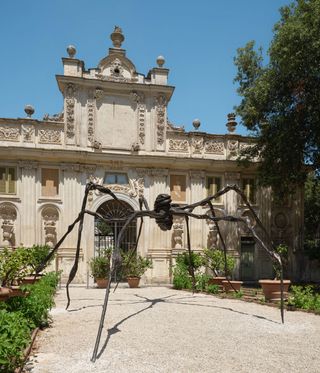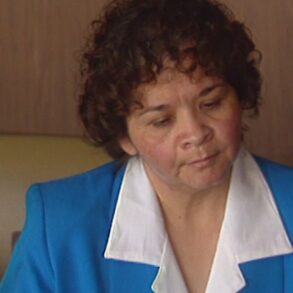This summer, Rome’s world-famous Galleria Borghese brings key sculptures from Louise Bourgeois’ oeuvre into dialogue with the museum’s collection of ancient Roman art, Bernini and Canova sculptures, Caravaggio, Titian and Raphael paintings, and the villa’s own 17th-century grandeur. At the centre of the magnificent entrance hall, famous for its sumptuous Mariano Rossi ceiling fresco, stands an imposing metal cell by Bourgeois entitled The Last Climb. It is one of the artist’s last cells, created in 2008, just two years before her passing.
Here, themes of mortality and ascension to a heaven beyond come into dialogue with Rossi’s neoclassical motifs, while other objects in the sombre circular cell serving as a self-portrait: the artist salvaged the metal staircase spiralling towards the skies from her former Brooklyn studio. Meanwhile, the barely perceivable threads running across the cell and its blue glass orbs are a reference to her mother, and her parents’ tapestry business.
‘Louise Bourgeois: Unconscious Memories’

(Image credit: © The Easton Foundation/Licensed bySIAE2024andVAGA at Artists Rights Society (ARS), NY. Ph.by A.Osio)
Entitled ‘Unconscious Memories’, it is the museum’s first exhibition dedicated to a contemporary female artist and the first show devoted to Bourgeois in Rome, despite the fact that the Italian capital played a key role in the sculptor’s artistic production. Louise Bourgeois first travelled to Italy in 1967. In letters sent to her husband, an art historian, she describes seeing the architectural wonders of the Palazzo Barberini staircases, and, of course, her visit to the museum at Galleria Borghese. ‘Six Berninis!’ she wrote. ‘For this show, we selected works that were either created in Italy or that have a deep connection with Italy,’ says Cloé Perroneand, who conceived and co-curated the show.
After Bourgeois’ initial trip to Italy, she introduced marble into her sculptural practice, several of which are exhibited here. The sculpture Jambes Enclacée (1990), installed facing Canova’s 19th-century marble masterpiece portraying Paolina Borghese Bonaparte as Venus, reverses the gendered roles of artist and muse: here, Bourgeois cast the legs of her longtime assistant and close friend Jerry Gorovoy, who is the president of the Easton Foundation, set up by Bourgeois. In the adjacent Apollo and Daphne room, the sculpture Topiary (2005), delightfully blends botanical myths to evoke a delicate physical transformation from childhood to womanhood.




(Image credit: © The Easton Foundation/Licensed bySIAE2024andVAGA at Artists Rights Society (ARS), NY. Ph.by A.Osio)
Bourgeois’ own childhood looms large in her sculptural body of work. Her parents’ restoration workshops, her mother’s untimely death, her sister’s disability, and her strict education are all worked into the monumental cell Passages Dangereux (1997), which occupies the grand loggia on the museum’s second floor.
Downstairs, soft sculptures of heads are installed amongst the marble busts of emperors, and Bernini’s towering Abduction of Proserpina. Bourgeois’ sculptures are made from scraps of precious tapestries and Gobelins from her parents’ shop. Some of the textures and motifs on the fabrics resemble the marble present all around them, on the floor, walls, and busts. Bourgeois’ heads – eyes and mouths wide open – appear almost non-human, their expressions minimal yet contemplative, alarmed, tormented even.




(Image credit: © The Easton Foundation/Licensed bySIAE2024andVAGA at Artists Rights Society (ARS), NY. Ph.by A.Osio)
The tug and pull of hardness and softness, compassion and restraint are omnipresent, and coexist in her signature. A sculpture titled Janus Fleuri (1968) is installed in dialogue with works in the museum’s Hermaphrodite gallery. Male and female themes are simply and poignantly combined in the hanging bronze sculpture, its dual identity always in flux as the work rotates slightly, suspended from a metal lever.
It appears as if no exhibition of works by Bourgeois can be complete without a soaring spider sculpture, and this show is no exception. A 1996 bronze spider stands at the far end of the villa’s historical meridian garden, where a series of bronze sculptures cast from the artist’s and Jerry Gorovoy’s interlocked hands are installed along its path. Louise Bourgeois’ fingers appear aged, marked by arthritis and years of work with materials of all kinds. Hands that have authored seminal artworks and paved paths for other women artists.
‘Louise Bourgeois: Unconscious Memories’ is on view at the Galleria Borghese, Rome until 15 September 2024. The exhibition is produced in collaboration with The Easton Foundation and the Academy of France – Villa Medici with Fendi as its main sponsor
galleriaborghese.beniculturali.it




(Image credit: © The Easton Foundation/Licensed bySIAE2024andVAGA at Artists Rights Society (ARS), NY. Ph.by A.Osio)






